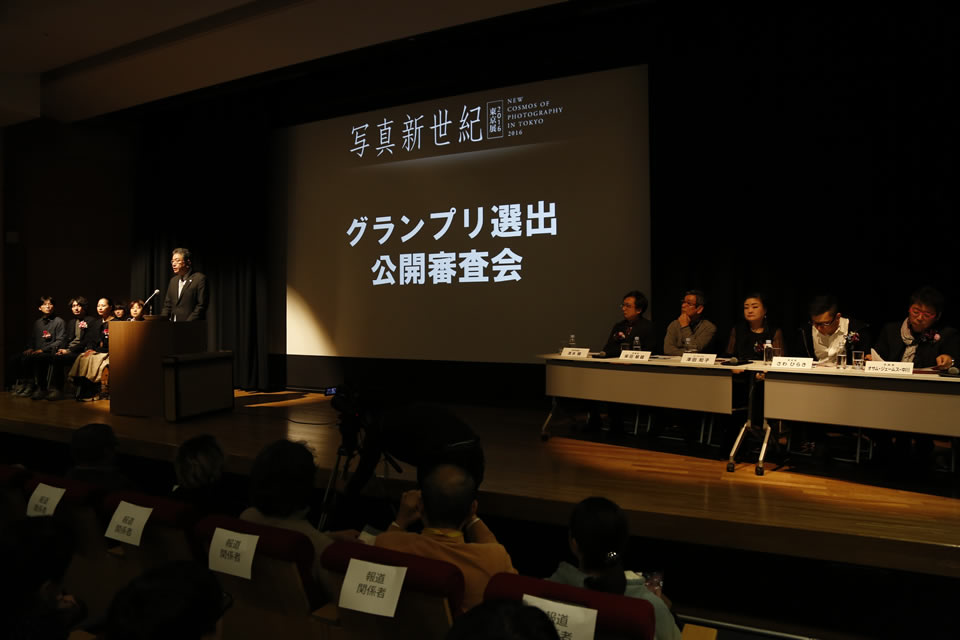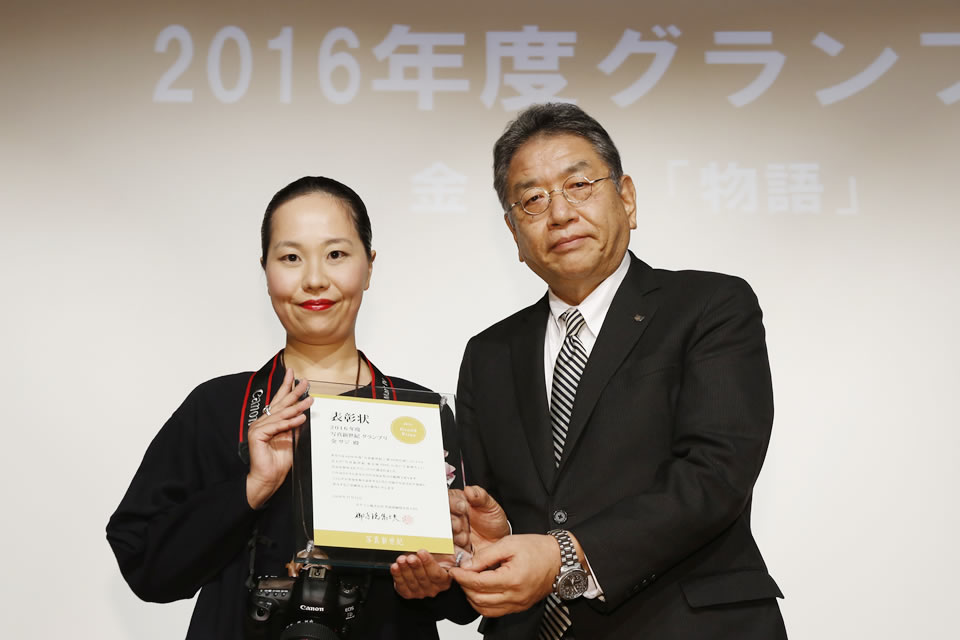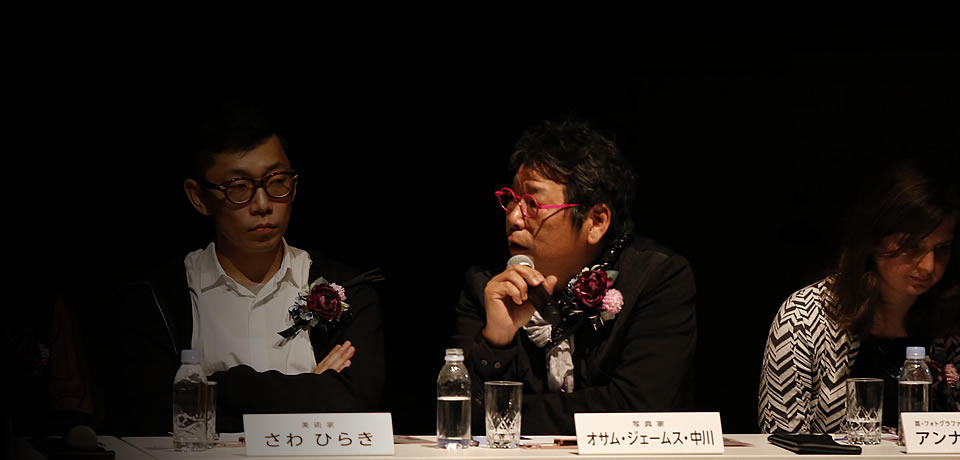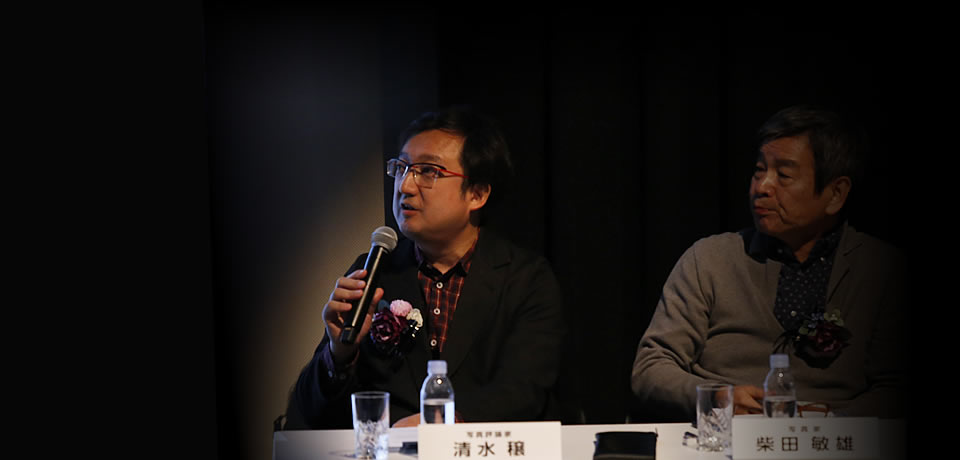The 2016 New Cosmos of Photography’s public Grand Prize selection meeting took place on Friday, November 11 at the Tokyo Photographic Art Museum.
The New Cosmos of Photography celebrated its 25th anniversary in 2015. It took this occasion as an opportunity to expand the scope of eligibility criteria to include entries of works in digital formats such as still images and videos, keeping pace with advances in photographic equipment. We are carrying out the contest on a global invitation basis with an entry system that welcomes works based on new perspectives regardless of genre and that encourages and supports artists’ creative activities.
For the current contest, seven judges took charge of selection including three newly invited ones from overseas, namely Anna Dannemann (Curator, The Photographers’ Gallery, London), Erin O’Toole (Curator, San Francisco Museum of Modern Art) and Osamu James Nakagawa (Photographer), in addition to Hiraki Sawa (Artist), Tomoko Sawada (Artist), Toshio Shibata (Photographer) and Minoru Shimizu (Photo critic). After screening, seven Excellence Award winners and 14 Honorable Mention Award winners were selected from 1,723 entrants.
At the public Grand Prize selection meeting, the seven Excellence Award winners (Natsumi Kawai, Kim Sajik, Kim Hyunseok, Sonoko Sakurai, Kuta Takashima, Yuu Matsui and Takuya Matsuura) made presentations and answered questions from the judges. After conferring with each other, the judges eventually selected Kim Sajik as the 2016 Grand Prize winner.
At 3 p.m., Friday, November 11, 2016, the public Grand Prize selection meeting opened to a tense atmosphere filled with mounting expectations. The candidates – the seven Excellence Award winners – each looking tense – began by taking their seats. Then six judges (Erin O’Toole was absent) appeared on stage, followed by Kazuhiko Noguchi, Operating Officer of Canon Inc., who delivered the opening address.

The seven Excellence Award winners took turns to make a 10-minute presentation, explaining the background and creative intentions behind their submitted works as well as their passion for their artwork and feelings about it. Some of the judges expressed praises and others offered sharp criticisms or asked questions, to which each candidate responded with a serious look.
You can see the state of the meeting with movie.
Following the presentations, the judges transferred to a separate room to deliberate for about 40 minutes. Finally, the Grand Prize winner was selected.
The 2016 Grand Prize winner was announced at the awards ceremony, where we presented Kim Sajik with the certificate of commendation, a list of monetary incentives, and a gift of a Canon digital single-lens reflex camera “EOS 5D Mark IV” as a supplementary prize.
Then, Teppei Sako, the 2015 Grand Prize winner, presented a bouquet to Kim Sajik with a congratulatory remark “Let’s do our best together!”
Kim Sajik responded with joy as the winner, saying, “The work I submitted this time was conceived about ten years ago and I have worked on it slowly and steadily. I’m extremely happy to know that the work I’ve created by honestly facing myself was appreciated and entered other people’s hearts in this way.”


This time, we, the judges, selected Kim Sajik unanimously. Your work truly conveyed to us your perspective from “in between” which is the core of your work. We would like you to continue to photograph creative works with such energy.

The seven Excellence Award winners in the current contest could be roughly divided into two types – the types commonly seen in the situation in which the art of contemporary photography is placed. Falling under type 1 are works based on the idea that photography is a means whereby light creates images; in these simple and direct images the creators attempt to find justification for their own existence. The work of Natsumi Kawai (bringing out an image after ten years of coating a photosensitive materials on a lacquer base) and that of Takuya Matsuura (the use of photogram to fructify sound into an image) represent type 1.
The other winners used collage – the technique of combining images commonly found in the world – as their methodology. It is true that collage is one contemporary style of expression. However, when it comes to whether works have the power sufficient enough to persuade people of the necessity of combining images in a collage, the work of Kim Sajik was outstanding. Of course, the other artists could win Excellence Awards because their photographic expressions were interesting. But we got the feeling that what they were doing somehow fell short of their intended creations or it seemed their end game was a little lacking, which led to the final result as you could see.
As for Kim Sajik, we wonder if it would be possible for her to come up with new expressions beyond her typical beautiful expression of, for example, making images emerge against the dark background, and wonder what uniquely original expressions she will be able to develop in the future. These will be her challenges, which we expect her to meet.
There has been one point on my mind regarding this contest since the previous year: our general impression that entries of works with political expressions have decreased considerably and, conversely, the number of photographs like novels depicting the creators’ private lives are increasing markedly. We would like to see more “muscular” photographic expressions that will allow us to come face-to-face with the reality of “hard-to-live-in Japan.”
